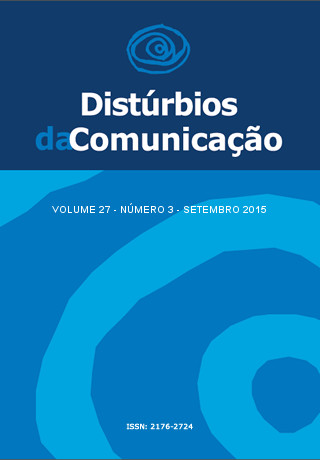Maximum phonation time and its relation to gender, age and living habits in healthy elderly
Keywords:
vital capacity, phonation, aged, respiration, voiceAbstract
Objective: To characterize and relate the maximum phonation time with gender, age and lifestyle in healthy elderly. Methods: 55 subjects, with 44 women and 11 men, average age 72, who answered a questionnaire developed by the researchers to identify with questions regarding gender, age, voice complaints, general health, physical activity and history of smoking and alcohol consumption. Maximum phonation times of vowels were collected /a/, /i/ and /u/ and the fricatives /s/ and /z/. Data were analyzed statistically using the non-parametric Mann-Whitnney and Pearson correlation. Results: The maximum phonation time of vowels /a/, /i/, /u/ and the fricatives /s/ and /z/ for males were 13,3s; 14,7s; 14,7s; 13,3s; 14,3s, respectively; and for females were13,1s; 14,3s; 14,8s; 13,0s; 13,1s respectively. No significant association of maximum phonation time was found with sex, regular physical activity, smoking history and vocal complaints. There was no significant correlation between maximum phonation time of vowels and fricatives and age. Conclusion: The maximum phonation time of elderly women have values close to those shown by young adult women. For males, there was a significant reduction in the maximum phonation time in relation to adulthood. When analyzed exclusively, the maximum phonation time unrelated to the variables related to gender, age, regular physical activity and smoking history..Downloads
Metrics
Downloads
Published
Issue
Section
License
Copyright (c) 2015 Caroline Silveira Coelho, Ellen Leticia Oliveira Alves, Vanessa Veis Ribeiro, Rosane Sampaio Santos, Ana Paula Dassie Leite

This work is licensed under a Creative Commons Attribution 4.0 International License.









